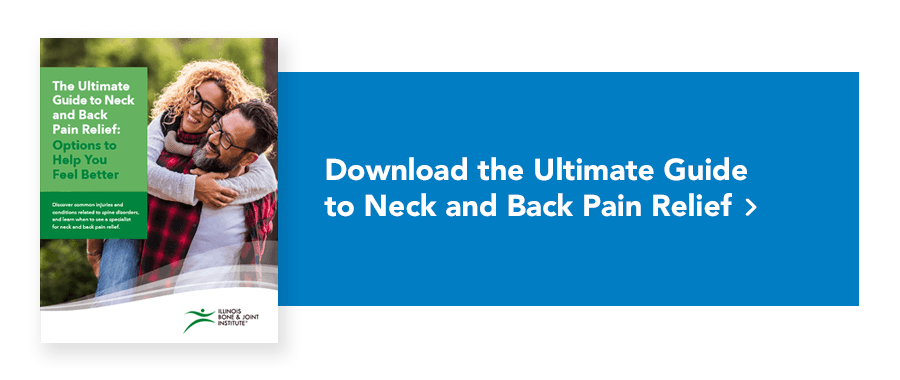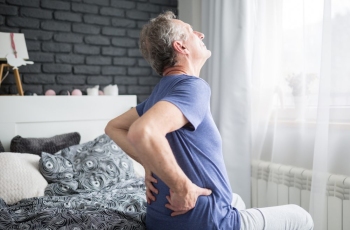A bulging disc or slipped disc is a common spinal column injury in the intervertebral disc due to neck/ back trauma or age related injury. It can occur in your lumbar spine (lower back), thoracic spine (upper and mid-back) or your cervical spine (neck). The intervertebral disc is weakened so much that it protrudes into the spinal canal either in the neck referred to as a cervical bulging disc, mid-back known as thoracic bulging disc or lower back identified as lumbar bulging disc. The bulge pinches nerve roots along the spinal cord to put additional pressure on the surrounding nerve tissue. Along with back pain and spasms, the signs you should watch out for are tingling and numbness that spread along the upper and lower extremities.
What is a Spinal Intervertebral Disc?
Spinal discs are made of cartilage and glycoprotein which act as the shock-absorbing rings separating your bony vertebral bodies. Spinal discs make space for spinal nerves to spread across to your limbs and allow for movement at each spinal level. Spinal disc injuries vary in degree from mild disc strains, moderate-severe disc bulges, to complete disc herniation of the jelly-like nucleus disc, which moves within the outer annulus modifying according to the pressures of the spine. When the outer wall or the annulus is weakened, the nucleus presses outwards against it leading to the disc bulging outwards.
Causes Of Bulging Disc
With a bulging disc, herniation or disc-rupture there may be a number of reasons for it, including:
- Vehicle accident
- Already existing annulus weakness
- Body mechanics and poor posture that put stress on the spinal disc
- Torsion of disc from repetitive work with a lot of bending, twisting or lifting
- Sitting, standing driving or working for long periods of time
- Sustaining back injury from a severe fall
- Repetitive forceful motions in certain sports
- Poor heavy lifting techniques, like bending forward to pull with your back can put sudden excessive load on the disc
- Abdominal fat and poor core stability
- Reduced lower limb strength.
- People genetically predisposed to have lesser density of fibrocartiliginous fibers that make up the disc.
Bulging Disc Symptoms
If your back pain is aggravated when sitting, bending forward, coughing and lifting then it may be bulging disc. There may be sciatica, muscle weakness in the neck, back or shoulders, pins and needles, weakness. Any change in bladder & bowel function is also a common symptom of severe disc pathologies.
Depending on the kind of bulging disc injury, discomfort from the symptoms may affect different regions:
Cervical spine – There will be associated discomfort in the neck, shoulders, arms and upper back.
Thoracic spine – The pain from the compressed nerve radiates in the ribs, middle back, or internal organs.
Lumbar spine – There are symptoms of an impinged nerve in the lower back, hips, buttocks, and lower extremities.
Bulging Disc Diagnosis and Treatment
A spinal disc injury is diagnosed based on clinical tests, such as MRI and CT scans, history of your injury and symptoms exhibited. Common treatment for spinal injuries should include rest, physical therapy, exercise and medications. The aim of any treatment for bulging disc injury is to allow the torn fibers of the annulus to heal with time and to encourage the return of fluid to the centre of the disc. To this end conservative treatment regimen should be followed:
Medication – Patients can benefit from taking over-the-counter NSAIDs, or prescription pain relievers muscle relaxants or Epidural steroid injections to manage their inflammation.
Physical therapy – Bulging disc symptoms can be reduced with the help of a physical therapist who can design personalized exercises or techniques to strengthen the muscles and de-stress the spinal structures in the neck and back. It may also include transcutaneous electrical nerve stimulation (TENS) stretching exercises, acupuncture, soft tissue massage, and use of a back brace temporarily to reduce pain and inflammation. With relief from spinal disc pain, the physiotherapist will recommend a progressive program to improve lower abdominal muscles and a core stability program to stabilize the spine for prevention of further injuries. With change in the back’s dynamics, the physio will work on the outer core and leg muscle to slowly restore normal pelvic and spine alignment for better range of motion during stressful body postures.
Lifestyle changes – It is important to shed excess weight and practice low-impact, gentle exercises daily to successfully prevent a spinal bulge recurrence. Gentle yoga, swimming, walking or even hydrotherapy may prove to be helpful in the long-run.
Physicians or spine specialists may typically recommend surgical treatment as a last resort for patients who get no relief from non-invasive treatments, after six to 12 weeks. Traditional, open neck or spine approaches to surgery for bulging discs can be highly invasive due to the large incisions required for the surgeon to access the spine. The affected intervertebral disc is completely removed and replaced by stabilizing implants. It has a high risk percentage but there are also viable alternatives like minimally invasive procedures for long term life benefits.
*This content is for information only and is not intended to replace the diagnosis, treatment, or medical advice from your treating healthcare professionals. The content does not provide medical advice, does not constitute the practice of medicine or other healthcare professional services, and does not create a doctor-patient relationship. You should not rely on this information as a substitute, nor does it replace professional medical advice, diagnosis, or treatment. If you have concerns or questions, seek the advice of your healthcare professionals. If you think you may have a medical emergency, call your doctor or 911 immediately. Do not rely on electronic communications or communicate through this website for immediate, urgent medical needs. This website is not designed to facilitate medical emergencies. The use of the information is at the reader’s own risk. The links are provided for information and convenience only. We cannot accept responsibility for the sites linked or the information found here. A link does not imply an endorsement of a site.





